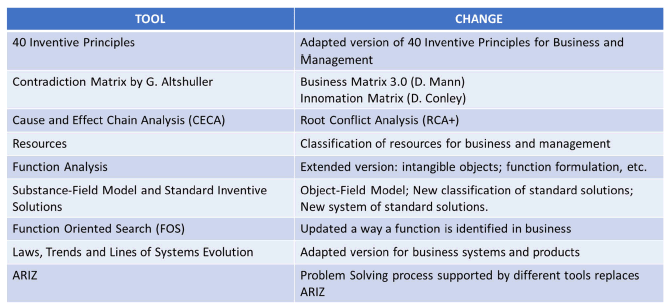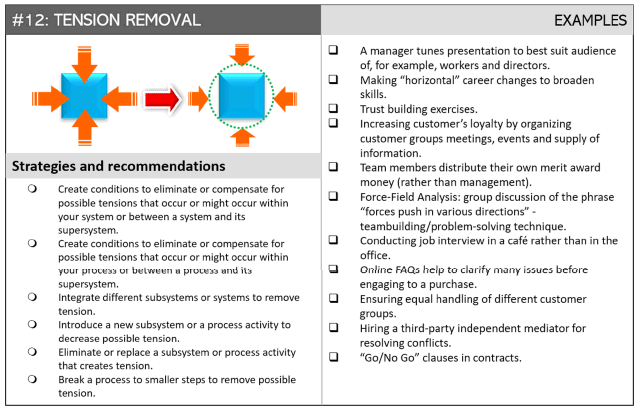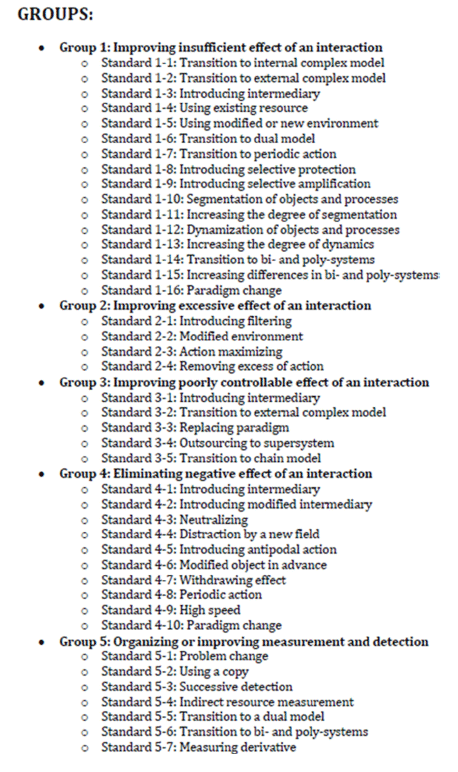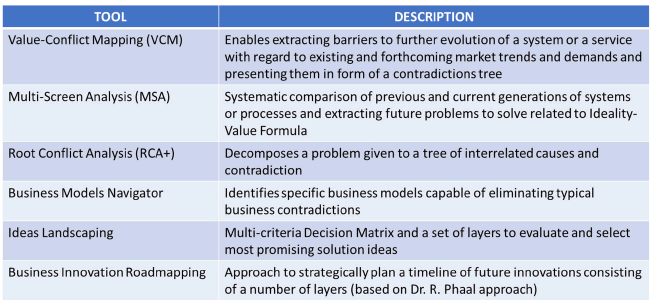Modern Tools for Business TRIZ
Valeri Souchkov (The Netherlands),
MATRIZ TRIZfest-2021: September 15-18, 2021
Japanese translation by Toru Nakagawa, Jul. 30, 2022
|
|
Modern Tools for Business TRIZ |
|
|
|
|
|
| Posted: Jul. 30, 2022; Updated: Nov. 1, 2022 |
For going to Japanese pages, press buttons.
Editor's Note (Toru Nakagawa, Apr. 14, 2021)
This is an excellent overview paper by Valeri Souchkov on the extension of TRIZ to the field of Business and Management. As the result of his (and others') research and practices, he has shown a full system of Modern (Adapted and New) Tools of TRIZ applicable to understand and solve various problems in Business and Management. He has recently organized the International Business TRIZ Association (IBTA) and installed the tools system (most of which he developed in ICG T&C) as the course material of the IBTA training & certification. Reading this overview, you are invited to read futher about the methods (or tools) for Business TRIZ through the References listed at the bottom.
This paper was presented at MATRIZ TRIZfest-2021, and may be referred in their open website. I obtained Author's permission of translating this paper into Japanese and posting it here both in English and in Japanese (on Jan. 1, 2022). I am very gratefull to Mr. Valeri Souchkov for his permission, and am happy to post it here in the two languages, with my apologies for so much delay. Fortunately, Japan TRIZ Society is inviting Valeri Souchkov as the Keynote Speaker in the coming Japan TRIZ Symposium 2022 (Sept. 1 - 2, 2022, online).
Note (TN, Nov. 1, 2022) This page was broken during Oct. 9 through Oct. 31, 2022 due to my mistake. Sorry for your inconvenience.
Abstract
| 3. Summary | Ref. | Paper PDF |
![]() Paper
Paper
Modern Tools for Business TRIZ
Valeri Souchkov
*ICG Training and Consulting, Enschede, The Netherlands
Abstract
In the early 1990s, first attempts were made to examine if a systematic approach used in TRIZ can be used beyond engineering: in particular, to assist supporting solving innovative problems and challenges within the areas of business and management. The experience gained since helps with drawing conclusions regarding the applicability of the approach as well as which parts of TRIZ can be directly used in the areas of business and management; which parts cannot be used or must be adapted; and what new knowledge is needed. The paper summarizes state-of-the-art of modern TRIZ tools for different types of innovative projects in business and management.
Keywords: TRIZ, Business Innovation, Innovation Training
For a long time, engineering innovation has been among the most important factors driving the progress of human civilization. Today it is obvious that business innovation is not less important to successfully compete and becomes the necessity. Modern business environment is extremely dynamic and fast, information technology and global networking eliminate borders, which used to keep businesses in their comfort zones, the market continuously demands better services, competition even between small companies moves to a global scale.
At the same time there was no solid and proven method that would support business innovation. In search for a solution, more and more businesspeople turn their attention to TRIZ. While TRIZ nowadays is primarily known and used in technology and engineering, applications of TRIZ in business and management areas have been practically unknown. It should not be surprising: TRIZ was created by engineers for engineers. The vast majority of TRIZ professionals work in the areas of engineering rather than business due to historic reasons.
In addition, most of TRIZ experts working in the technology areas are vaguely familiar with specifics of business environments. It became obvious that a separate version TRIZ for Business and Management was needed.
Relatively recently, TRIZ developers started to expand application of TRIZ to business and management areas [1, 2, 3, 4, 5, 6].
The results appeared to be rather encouraging: a number of seemingly unsolvable business and management problems were solved quite effectively and efficiently. Such situation triggered further development of TRIZ for Business and Management, which has been actively evolving during recent years. A major step in further promotion of "Business TRIZ" was made by introduction of Darrell Mann's book "Hands-On Systematic Innovation for Business and Management" [7] in 2004. It triggered performing further experiments by business professionals in academia and industry.
In contrast to engineering innovation which occurs either in a technical product or in a manufacturing or a production process, innovative solutions in business and management have a broader scope and can occur at different places of a specific business ecosystem (Fig. 1). Red spots in the figure demonstrate where such innovations can usually take place.
Note that sometimes, to achieve improvement of collaborative efforts within the value network, innovation of a business system of a supplier can be demanded.
Fig 1. Red spots mark places where business and management innovation can take place.
As we all know, modern TRIZ is based on the assumption that all technical systems evolve according to certain regularities. Once we know these regularities, we are capable of predicting future evolution of systems and considerably lower the risks when choosing the direction of innovative changes. This assumption is based on the basic model of a technical system proposed in the early times of developing TRIZ by the author of TRIZ G. Altshuller (Fig 2).
It becomes obvious that the same assumption – evolution of applies to business systems, but with its own regularities. To unify business systems and to extract the patterns of evolution of business systems, a TRIZ-based model of a business system was suggested (Fig 3) [8]. Currently such a model is considered as fundamental and is used as a basic during the development of different TRIZ tools for business and management.
Fig. 2. Models or a Technical System in TRIZ
Fig. 3. Model of a Business System in TRIZ
A business system is a model of an organization which converts some input to a certain output by adding value. As seen, a model of a business systems resembles a technical system although includes different parts. Nevertheless, a conceptual similarity at a functional level helps to establish analogies and conduct many parallels. First of all, both technical and business systems are utilitarian systems, which are created artificially to satisfy some human goals and meet certain demands.
However, numerous attempts in the past to directly apply technical TRIZ to create business innovations or solve business problems mostly failed.
One of the reasons is a cognitive bias. When we explain TRIZ principles with the help of technical examples, non-technical people will understand the examples, but they will hardly connect it with their own area of competence and therefore will not capture these principles and incorporate them to their own practice.
To solve this problem, during a number of years, studies were conducted to understand which and how some parts of TRIZ can be adapted to business language and business tasks.
As a result, it was proposed to distinguish a different direction within TRIZ for systematic applications of TRIZ principles for business innovation, which is today known as "Business TRIZ".
2. Modern Business TRIZ
Modern Business TRIZ is a result of 20 years of adaptations and developments. Its tools are smilar to the tools of technical TRIZ, including classical ones. They are structured to the currucila accordingly three large areas of competence (Fig. 3):
- Tools for solving specific stand-alone problems.
- Tools for analysing systems and processes, and extracting and ranking of problems. Disruptive innovations and process/systems cost cutting.
- Tools for future forecast, breakthrough innovations, and antcipating failures.
Figure 4. Three levels represent the current structure of Business TRIZ
Table 1 shows tools which are included to a modern training program for Business TRIZ. Similar to MATRIZ curricula for technical TRIZ, it consists of three competence levels.
Table 1. Tools of Business TRIZ in the current Business TRIZ Curricula
Today, these levels of competence are implemented in a training and certification program developed by the International Business TRIZ Association (IBTA) [9].
Currently, the following three groups of tools are in the program:
Tools of classical TRIZ which remained unchanged.
Adapted tools: classical and modern tools of technical TRIZ which were incorporated to Business TRIZ but underwent slight or serious adaptations.
- New tools which were developed for Business TRIZ.
2.1 Adapted Tools
As mentioned above, adapted tools represent the largest group of TRIZ tools. They are listed in Table 2.
Table 2. Adapted tools of TRIZ

To illustrate the changes, let us take a look at two most known problem solving tools of TRIZ: 40 Inventive Principles and 76 Standard Inventive Solutions.
In particular, a modified version of the most famous TRIZ tools - 40 Inventive Principles for eliminating technical contradictions, contains the following changes:
Partly changed the content of each principle to adapt it to business terminology.
Completely changed contents of Inventive Principles 8, 9, 12, 14, 18, 19, 28, 29, 30, 31, 36, 37, 38
Changed the titles of Inventive Principles 12, 14, 18, 28, 29, 30, 31, 32, 36, 37, 38.
In each principle were changed the quantity of subprinciples, and currently the system includes of 192 recommendations.
An example of an updated inventive principle #12 is shown in Fig. 5.

Fig. 5. An Inventive Principle for Business and Management.
Similarly, the new matrix of contradiction elimination for business and management is available and consists of 45 business parameters [10].
The same applies to what is known as "Standard Inventive Solutions". A classical TRIZ System of Standard Inventive Solution is based on a so-called "su-field" (substance-field) analysis and consists of 76 standard solutions. Although the approach can be effectively used for solving business and management problems, using the word "substance" would be obscure. Therefore a model was changed: rather that "substance-field", an "object-field" analysis is used.
Examples of two modified and adapted Standard Inventive Solutions for business and Management are shown in Fig. 6.

Fig 6. Two examples of Standard Inventive Solutions for Business TRIZ.
In addition, the inventive standards are grouped differently than in technical TRIZ. While in technical TRIZ they are grouped according the line of evolution of technical systems, in Business TRIZ, standard inventive solutions are grouped according to the type of problems they solve. In total, there are 5 groups of problems [11] (Fig. 7).

Fig 7. Current structure of a System of Inventive Standards
2.2 New Tools
In addition, new tools for Business TRIZ were developed. Some of them appear to be universal and can be applied to both technical and Business TRIZ [11]. They are listed in Table 3.
Table 3. New tools of TRIZ

Descriptions of most of these tools are presented in [12].
Specifically, we can outline the tool "Business Model Navigator" which was developed to eliminate contradictions by replacing business model [13].
Summary
This paper was supposed to give a short overview of tools included today to the training and certification program of the International Business TRIZ Association (IBTA) which set up a goal to develop the top quality standards of training in TRIZ for Business and Management.
Taking to account relatively short time of implementing the program, IBTA looks forward to expanding its activities, in particular, accreditation of new trainers, thus gathering more customer feedback to improve its training program.
References
Zlotin B. & Zussman A. "Evolution of Organizations". Materials of TRIZ Course, Kishinev, Moldova, 1991. (in Russian)
Mann D. & Domb E. "40 Inventive (business) principles with examples", The TRIZ Journal, September 1999.
Souchkov V. "M-TRIZ: Application of TRIZ to Solve Business Problem", Insytec white paper, June 1999.
Ishida Atsuko. "Using TRIZ to Create Innovative Business Models and Products". In Proceedings of International Conference TRIZ Future 2003, November 12-14, 2003, Aachen, Germany.
Averboukh E. "I-TRIZ for Six Sigma Business Process Management", The Online TRIZ Journal, December 2003.
Smith H. "P-TRIZ Formulation", #2 in a series, BPTrends.com, March 2006.
Mann D. "Hands on Systematic Innovation: For Business and Management". Edward Gaskell Publishers, 2004
Souchkov, V, "Typical Patterns of Business Model Innovation". In Special Issue: Selected papers presented at the 15th International TRIZ Future Conference "Global Structured Innovation", Berlin, 26.-29.10.2015. pp 121-127
Website of the International Business TRIZ Association (IBTA), www.biztriz.net . Last seen September 10, 2021.
Mann, D. "Business Matrix 3.0. Solving Management, People and Process Contradictions", IFR Press., 2018.
Souchkov V., Roxas J.P. "A System of Standard Inventive Solution Patterns for Business and Management problems". In Proceedings of the 12th International Conference TRIZfest 2016. The International TRIZ Association - MATRIZ. July 28-30, Beijing, China. 2016. pp 22-35.
Souchkov V. "Materials of Training for TRIZ and Systematic Innovation for Business and Management: Levels 1-3". ICG Training & Consulting, Enschede, The Netherlands, 2007-2021.
Kuryan A. & Rubin M. "TRIZ-Navigator for Business Models". In Proceedings of the 13th International Conference TRIZfest 2017. The International TRIZ Association - MATRIZ. September 14-16. 2017. pp 514-525.
Communicating Author:
Valeri Souchkov, valeri@xtriz.com
| 3. Summary | Ref. | Paper PDF |
Last updated on Nov. 1, 2022. Access point: Editor: nakagawa@ogu.ac.jp